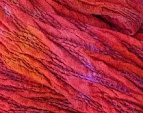I'll try to explain this structure.
A unit weave refers to a group or block of threads in warp and weft which are threaded or treadled in a particular way to produce pattern.
A tied unit weave is a unit weave in which a supplementary pattern weft is tied to the cloth by designated warp threads called "tie-down ends". Each threading unit consists of tie-down ends and pattern ends. The tie-down ends are threaded on the same shafts throughout while the pattern ends are threaded on different shafts in each block. Based on information from The Complete Book of Drafting for Handweavers by Madelyn van der Hoogt.
Two-tie refers to the number of tie-down threads in each unit or block, e.g. in this instance its 2 but could be 3 or 4.
Double refers to the number of pattern threads in the unit or block.
In my particular Kete pattern the tie-down threads are 1 and 2 so a unit would be 1, 3, 2, 4 and the next unit 1, 5, 2, 6 etc with all shafts from 3 upwards being pattern shafts. (In Summer and Winter each unit uses one pattern shaft making it very economic 1,3,2,3 and 1,4,2,4.)
And double layer means its woven in two layers joined on one side to get the width on my 32" wide 16 shaft
loom. Odd shafts are used for the top layer and even shafts for the bottom layer which means I use 1 and 3 as tie-down threads on the odd layer and 2 and 4 on the even and all others are pattern threads for the respective layers.
Excellent reference books include:
The Complete Book of Drafting for Handweavers by Madelyn van der hoogt
A weaver's book of 8 shaft patterns edited by Carol Strickler (Chapter 10, Plaited Twills)
I haven't seen a copy but the above 8 shaft book refers to
Double two-tie unit weaves by Clotilde Barrett and Eunice Smith
Hope this explanation helps.
A unit weave refers to a group or block of threads in warp and weft which are threaded or treadled in a particular way to produce pattern.
A tied unit weave is a unit weave in which a supplementary pattern weft is tied to the cloth by designated warp threads called "tie-down ends". Each threading unit consists of tie-down ends and pattern ends. The tie-down ends are threaded on the same shafts throughout while the pattern ends are threaded on different shafts in each block. Based on information from The Complete Book of Drafting for Handweavers by Madelyn van der Hoogt.
Two-tie refers to the number of tie-down threads in each unit or block, e.g. in this instance its 2 but could be 3 or 4.
Double refers to the number of pattern threads in the unit or block.
In my particular Kete pattern the tie-down threads are 1 and 2 so a unit would be 1, 3, 2, 4 and the next unit 1, 5, 2, 6 etc with all shafts from 3 upwards being pattern shafts. (In Summer and Winter each unit uses one pattern shaft making it very economic 1,3,2,3 and 1,4,2,4.)
And double layer means its woven in two layers joined on one side to get the width on my 32" wide 16 shaft
loom. Odd shafts are used for the top layer and even shafts for the bottom layer which means I use 1 and 3 as tie-down threads on the odd layer and 2 and 4 on the even and all others are pattern threads for the respective layers.
Excellent reference books include:
The Complete Book of Drafting for Handweavers by Madelyn van der hoogt
A weaver's book of 8 shaft patterns edited by Carol Strickler (Chapter 10, Plaited Twills)
I haven't seen a copy but the above 8 shaft book refers to
Double two-tie unit weaves by Clotilde Barrett and Eunice Smith
Hope this explanation helps.

Hi Dianne. Great post! Thank-you so much for your clear and concise description of this weave structure; you make it sound so simple, even easy. However, I must admit that I'm having trouble visualising this process, so I shall copy your notes and access my copy of MvdHoogt's book, and make them my bedside reading. Happy weaving, Regards, Wb
ReplyDelete